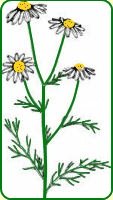Health Benefits of Chamomile

The health benefits of chamomile include safe, soothing stress relief. Although it is possible to have an allergic reaction to chamomile, it is usually considered safe enough for even the elderly and young children.
There
are two kinds of chamomile, Roman Chamomile (Chamaemelum nobilis) and
German Chamomile (Matricaria recutita). Their actions are quite
similar. The German Chamomile is usually used in the United States.
It
is tastier and more effective for soothing digestion.
Health Benefits of Chamomile Have a Long History in Traditional Herbal Medicine
- This gentle herb can relax muscles and have a calming influence on nervous irritability and anxiety.
- It can promote proper functioning of the stomach, improve digestion and dispel accumulated gas.
- It is often used for babies suffering from colic spasms or teething irritability.
- Chamomile has an anti inflammatory action and can promote healing of wounds.
- It can help promote perspiration and have a beneficial influence on fevers, colds and flu.
- It can help with nervous headaches, insomnia, and irritable bowel syndrome.
- Chamomile supports refreshing and relaxing sleep.
- It is useful for nervousness due to common every day over work and fatigue.
- Chamomile has a gentle calming sedative effect on the central nervous system.
- It is often recommended by herbalists to ease the impact of stress.
That's quite a lot of relief from one simple herb!
Constituents of Chamomile
The health benefits of chamomile seem to come from its unique assortment of natural plant oils including azulene, chamazulene, pro azulenes, bisabolol, farnesine, pinene, anthermal, spiroether, angelic acid and a number of various sesquiterpenes.
The beneficial phyto nutrients in chamomile include flavones, glycosides, bitter glycosides, valerianic acids, tannins, salicylic acid and coumarin derivatives.
Using Chamomile
Chamomile can be used as capsules and tincture. Most often it is probably used as a simple tea.
The tea can be used as a relaxing foot bath. It can also be used as a mouth wash for sores in the mouth, or as a gargle to soothe a sore throat. I have also seen it used as a hair rinse to bring out golden highlights.
How to Make Chamomile Tea
- Boil water
- Place dried chamomile blossoms in a tea pot or cup
- Use about 1to 2 teaspoons of blossoms per 8 ounce cup of water
- Pour boiling water over the blossoms and cover the pot or cup
- Allow the tea to steep for 30-45 minutes
- Drink and enjoy
Availability

Chamomile is a common herb which is widely available. The health benefits of chamomile can be obtained by purchasing this inexpensive herb in most health food stores. It grows freely in many gardens. In fact the Victorians used to create a whole lawn of chamomile blossoms which were very soothing to relax on. (If you decide to try this, be sure to border your lawn with bricks or stones which will inhibit invasion of weeds and other grasses.)
This page is not intended to be medical advice. It is always wise to consult with a trained health care professional for appropriate recommendations for your situation.
From here you can read about other natural stress relief herbs, or
For a broader range of natural stress relief ideas
return to Gentle Stress Relief home page.
Sources:
Winston, David and Maimes, Steven. 2007. Adaptogens Herbs for Strength, Stamina, and Stress Relief. Rochester, Vermont: Healing Arts Press
Smith, Ed. 2007, 2006, 2003, 1999. Therapeutic Herb Manual A Guide to the Safe and Effective Use of Liquid Herbal Extracts. Williams Oregon: Ed Smith
Hoffmann, David. 2003. Medical Herbalism The Science and Practice of Herbal Medicine. Rochester Vermont: Healing Arts Press
Herbs, Gaia. 2009. “Chamomile Flowers (Matricaria recutita).” http://www.gaiaherbs.com/herb_of_the_week.php?id=31